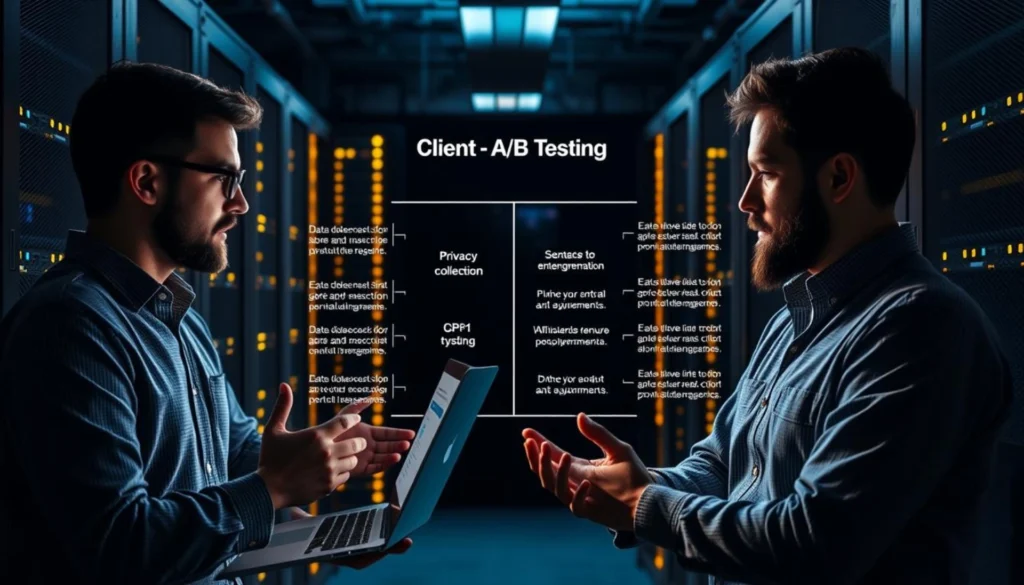What if the numbers you trust are leading you astray? Imagine making critical business choices based on flawed results—only to watch revenue plummet and credibility crumble. Sound dramatic? It’s not. Even minor errors in your experimentation process can snowball into catastrophic outcomes.

I’ve seen teams lose management buy-in after repeated “surprises” from unreliable metrics. Why? Because experiments aren’t just about launching variations—they’re about building trust. When flawed methods skew outcomes, stakeholders start questioning every decision. Ronny Kohavi, who led experimentation at Microsoft and Airbnb, calls this the “credibility death spiral”—a cycle where poor insights erode confidence, stifling future innovation.
But here’s the truth: tools alone won’t save you. The difference between guessing and knowing lies in how you validate your process. Are you measuring noise or real signals? This guide will show you how to spot hidden traps, from skewed sample sizes to misconfigured tracking, so your next test delivers actionable truth—not costly fiction.
Key Takeaways
- Flawed experiment results can lead to revenue loss and damaged team credibility.
- Trustworthy insights require rigorous validation, not just launching tests.
- Common pitfalls include skewed samples and improper tracking setups.
- Loss of stakeholder confidence threatens long-term testing programs.
- Experts like Ronny Kohavi emphasize proactive data health checks.
Understanding A/B Testing and the Importance of Data Quality
How confident are you that your split tests reveal real customer preferences? These comparisons pit two versions of a webpage, email, or ad against each other to uncover what truly works. Visitors see one variant, while others encounter an alternative. Metrics like sign-ups, clicks, or purchases decide the winner.

This method replaces hunches with evidence. I’ve watched teams pivot entire campaigns because numbers showed a 10% boost in engagement from a simple button color change. When done right, it’s like having a compass in a foggy landscape—you stop drifting and start navigating.
The Role of Metrics in Trustworthy Comparisons
Flawed information creates costly illusions. Last year, a client nearly doubled their checkout page’s loading speed because their tools misreported mobile traffic. They wasted three months solving the wrong problem. Garbage in, garbage out—always.
Split testing thrives on precision. Track bounce rates? Verify your analytics code. Measuring revenue? Cross-check payment gateways. Every digit must withstand scrutiny, because today’s experiments shape tomorrow’s strategy. In a world where 88% of shoppers abandon sites after poor experiences (Baymard Institute), there’s no room for guesswork.
Your tools are only as good as their setup. Regular audits catch issues like skewed traffic splits or broken tracking pixels before they corrupt results. Build processes, not just variations—that’s how you turn tests into triumphs.
Recognizing Testing Pitfalls That Skew Your Data
Ever wonder why some experiments deliver conflicting outcomes? The answer often lies in overlooked flaws that distort insights. Even minor missteps can turn actionable findings into expensive guesses.

Common Issues Impairing Test Results
One client insisted their checkout redesign boosted sales by 15%—until we discovered they’d stopped the trial after just three days. Peeking at outcomes prematurely creates false positives 37% more often (Harvard Business Review). This “quick check” habit ruins statistical validity.
Mismatched goals are equally dangerous. I once saw a team measure newsletter sign-ups while testing headline changes—two unrelated metrics. When your conversion target doesn’t match the test’s purpose, you’re tracking noise.
Bot traffic remains a silent saboteur. Automated visits accounted for 22% of one retailer’s “users,” skewing their sample ratios. Filtering these out revealed their true conversion rate was 9% lower than reported.
Impact on Conversion and Revenue
Platform discrepancies compound errors. A SaaS company found Google Analytics showed 12% higher trial starts than their payment processor. Choosing one source prevented costly misallocations in their $500K ad budget.
These issues hit profits hard. That bot-infected retailer lost $18K monthly until we fixed their filters. Another brand wasted $74K implementing a “winning” variation that actually reduced mobile purchases by 8%.
As one growth lead told me: “Bad tests don’t just waste time—they steer ships into icebergs.” Spotting these traps early keeps your strategy watertight.
Ensuring A/B testing data quality: Tools and Techniques
Would you drive a car without dashboard warnings? Modern experimentation demands more than basic split-testing software—it requires systems that flag issues before they distort outcomes. Let’s explore the instruments that separate reliable insights from risky assumptions.
Leveraging Proper Analytics Tools
Start with power calculators—your first defense against underpowered experiments. These tools calculate required sample sizes based on traffic volume, baseline performance, and desired sensitivity. One client discovered their “failed” test lacked sufficient participants to detect a 5% lift—a fixable oversight.
Platforms like Kameleoon take this further with built-in safeguards. Their SRM detector acts like a smoke alarm for uneven traffic splits, sending instant alerts when ratios skew. One e-commerce team avoided flawed conclusions after catching a 55/45 visitor imbalance mid-test.
Setting Up Effective Health Checks
Real-time monitoring systems scan for anomalies 24/7. Imagine tracking 12 metrics when a sudden traffic spike distorts conversion rates. Automated checks freeze tests during irregularities, preventing garbage conclusions.
I recommend configuring three core guardrails:
- Traffic allocation audits
- Bot filtration thresholds
- Statistical significance triggers
These layers work like airport security scanners—catching issues most miss. One SaaS company reduced false positives by 68% after implementing hourly tracking verification.
Examining the Role of Statistical Significance in A/B Tests
How often do your experiment conclusions hinge on misunderstood numbers? Statistical significance acts as your truth detector—separating real patterns from random noise. Without it, you might celebrate false wins or abandon promising changes.
At its core, this concept answers one question: “Could these outcomes occur by chance?” Tools calculate a p-value—the probability of seeing differences if no actual change exists. When this value drops below 5% (p ≤0.05), we reject the “no difference” assumption.
Decoding p-values and Their Misinterpretations
Many teams misinterpret p=0.05 as 95% confidence in their variation’s superiority. That’s dangerous. The correct interpretation? There’s ≤5% chance of observing these results if the original version performs equally well.
| Common Misbelief | Reality | Business Impact |
|---|---|---|
| p=0.05 = 95% certainty | Means 5% false positive risk | Overconfident decisions |
| Significance = success | Ignores effect size | Wasted resources |
| Early stopping is safe | Inflates error rates | Flawed rollouts |
Practical significance matters too. I once saw a 0.3% conversion lift hit p=0.04—statistically valid, but implementing those changes would’ve cost more than the gains. Always ask: “Do these numbers justify action?”
Focus on three steps:
- Set significance thresholds before launching
- Calculate required sample sizes upfront
- Compare statistical outcomes with cost-benefit analysis
Master this balance, and you’ll stop chasing ghosts in your metrics.
Avoiding Insufficient Statistical Power in Your Tests
What happens when your experiment’s engine lacks horsepower? Statistical power determines whether you’ll detect true performance differences—or miss them entirely. Power represents the likelihood of spotting real conversion changes when they exist. Industry standards demand at least 80% power for reliable insights.
Low-powered studies create dangerous illusions. Georgi Georgiev, author of Statistical Methods in Online A/B Testing, warns:
“Underpowered experiments magnify effect sizes like funhouse mirrors—what looks massive might be microscopic.”
I’ve witnessed teams celebrate 25% lifts that vanished upon retesting with proper sample sizes.
| Sample Size | Minimum Detectable Effect | Statistical Power |
|---|---|---|
| 500 visitors | 10% lift needed | 62% |
| 1,200 visitors | 5% lift needed | 80% |
| 3,000 visitors | 2% lift needed | 91% |
Three critical steps prevent power pitfalls:
- Run power analysis before launching experiments
- Set minimum detectable effect based on business impact
- Monitor actual vs. planned participant counts daily
One SaaS company learned this harshly. Their “15% conversion boost” from a 700-user test collapsed to 3% upon scaling. The premature rollout cost $28K in development fees and customer confusion. Don’t let small samples bigfoot your decisions—calculate, verify, then trust.
Diagnosing and Preventing Sample Ratio Mismatch (SRM)
Your split tests might be silently sabotaging your decisions. Sample Ratio Mismatch occurs when visitors aren’t distributed evenly between variations—even a 0.2% imbalance can invalidate results. Imagine pouring two coffee cups but one gets 2.1 oz while the other receives 1.9 oz. That tiny difference changes the taste experience entirely.
Studies show 6% of experiments suffer from SRM—often unnoticed. I’ve seen teams implement “winning” variants that actually underperformed due to skewed allocations. One client nearly rolled out a checkout redesign that appeared 8% better, but uneven traffic splits created this illusion.
Three primary culprits cause SRM:
- Redirect errors forcing users into specific variants
- Randomization flaws for mobile or logged-in visitors
- Cookie conflicts resetting user assignments
Spotting mismatches requires detective work. Monitor conversion rates across traffic sources—paid ads might funnel users to one variation. Check daily allocation charts for sudden dips or spikes. Tools like Statsig automatically flag deviations exceeding preset thresholds.
When troubleshooting, start with these steps:
- Compare user counts per variation hourly/daily
- Segment traffic by device type and geography
- Audit third-party scripts affecting page loads
Prevention beats correction. Choose platforms with built-in SRM detectors that pause flawed tests. As one engineering lead told me: “Automated safeguards are seatbelts for your experimentation pipeline—you’ll never regret using them.”
The Value of Running A/A Tests for Trustworthy Results
How do you know your experiment results aren’t just digital smoke and mirrors? Enter A/A testing—the unsung hero of reliable experimentation. This method splits users between identical variants to validate your setup’s integrity.
Spotting Ghosts in the Machine
I’ve used A/A comparisons to expose tracking failures that skewed results for months. When identical pages show statistically different outcomes, you’ve found a system leak. One client discovered their mobile users received variant B 63% of the time due to a caching bug—invisible without this diagnostic.
Critics argue these tests waste resources. Here’s the hack: analyze historical data instead. Split past experiment records randomly. If more than 5% show false positives, your framework needs fixing. One team found 12% significance in old A/A splits—revealing broken session recording.
Key takeaway: Treat A/A checks like annual physicals for your tech stack. Run them quarterly or after major system updates. Trust isn’t built through tools—it’s earned through relentless verification.
FAQ
Why does data quality matter for my experiments?
Reliable insights depend on clean data. If your analytics tools misreport traffic, track incomplete user behavior, or fail to segment audiences properly, your decisions will be based on flawed assumptions. I prioritize regular audits to ensure metrics like conversion rates and engagement align with actual performance.
How do skewed results impact my business goals?
Errors like sample ratio mismatches or insufficient statistical power can lead to false positives. For example, you might wrongly attribute a revenue boost to a button color change when external factors like seasonality influenced conversions. I’ve seen teams waste months optimizing irrelevant elements due to such oversights.
What tools help maintain trustworthy tests?
Platforms like Google Optimize, Optimizely, or VWO offer built-in health checks for issues like uneven traffic distribution. I also use heatmaps from Hotjar to validate user behavior patterns and Mixpanel for granular event tracking. Combining these reduces blind spots in your experiment setup.
Are p-values the only metric for reliable conclusions?
No. While a p-value below 0.05 indicates statistical significance, it doesn’t measure practical impact. I pair it with confidence intervals to assess the magnitude of change. For instance, a “significant” 0.1% lift in sign-ups might not justify redesigning your entire homepage.
How do I avoid underpowered experiments?
Calculate required sample sizes upfront using tools like Statsig or Evan’s Awesome A/B Tools. If your site has low traffic, consider sequential testing methods. I’ve adjusted test durations based on historical conversion rates to ensure adequate sensitivity for detecting meaningful differences.
What causes sample ratio mismatch?
SRM often stems from technical errors like faulty randomization scripts, bot traffic inflating one variation, or CDN caching issues. I run pre-test diagnostics using tools like SparkBeyond to detect anomalies before launching experiments. Catching these early prevents skewed allocations.
Why run A/A tests if there’s no change?
They reveal hidden biases in your setup. If control and variation groups show statistically different outcomes despite identical experiences, it signals deeper issues—like tracking errors or audience segmentation flaws. I use A/A tests quarterly to validate my analytics infrastructure’s integrity.





